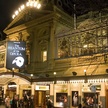Princess Theatre
The original theatre was built in 1854 by the actor-manager George Coppin and was called Astley’s Ampitheatre. It contained a central ring for equestrian entertainment and, at one end, a stage for dramatic performances. In 1857, it remodelled and re-opened as the Princess Theatre and Opera House. In 1885, the complex was under the ownership of partners J C Williamson, George Musgrove, and Arthur Garner. A new building designed by William Pitt in Second Empire Style was erected in 1886 with an interior designed by George Gordon. The project cost £50,000. The building had the world’s first sliding, or retractable, roof and featured state-of-the-art electrical stage lighting. The marble staircase was favourably compared with those at the Paris Opera, the Frankfurt Stadt, and the Grand in Bordeaux. The building was again renovated in 1922 by new owners Ben Fuller and Hugh J Ward. Another renovation occurred in 1987 when David Marriner bought the theatre, re-opening with Les Misérables, followed by The Phantom of the Opera.
The theatre even, reputedly, has its own ghost. In 1888, the baritone Frederick Baker (stage name Frederick Federici) was playing Mephistopheles in Gounod’s opera Faust. As usual, the opera ended with Mephistopheles sinking dramatically through a trap door as he returned to the fires of hell with Dr Faustus. But as Federici was lowered into the theatre basement, he had a heart attack, and died instantly. There he lay, lifeless on the floor, in his crimson robes. The cast were astonished to be told of his death because, they all swore, Federici had just been on stage with them taking his bows. For many years thereafter, the third-row seat in the dress circle was kept vacant in his honour.
Past productions
- 163 Spring Street, Melbourne, Victoria, VIC 3000
- Opened 1854
- Official website
- Wikipedia
- Edit this place’s information
- Add a production here
- This is a duplicate of another place
- A–Z of all productions at this place
If you have a photograph or picture of this place, please sign in to upload it, or add it to Flickr and tag it with .


